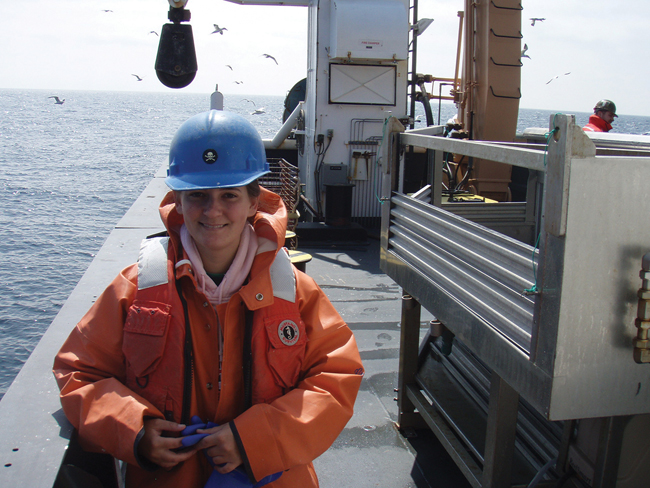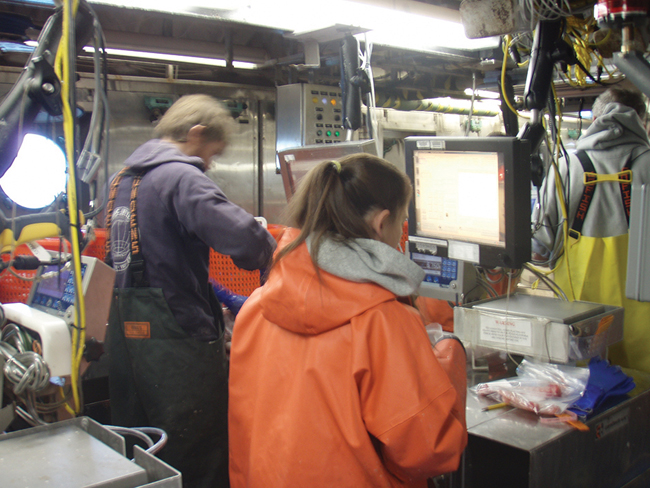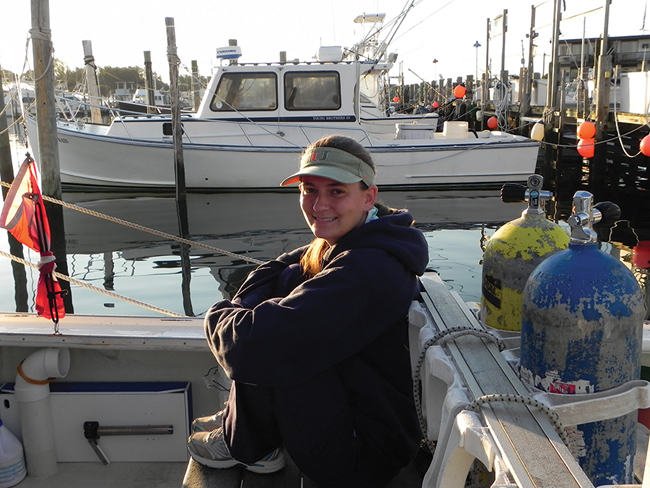
Fisheries Fellow Skyler Sagarese aboard a trawling vessel from the Bigelow Laboratory for Ocean Sciences, Maine. Credit: Skyler Sagarese
— Barbara A. Branca
Can a childhood obsession with sharks mature someone into becoming a leading expert?
Stony Brook, NY, December 16, 2016 - Such has been the path of Skyler Rose Sagarese, a native New Yorker and Ph.D. research ecologist at the National Marine Fisheries Service Southeast Fisheries Science Center in Miami, a path made clear by the NMFS Sea Grant Fellowship in Population Dynamics.
Since inception, New York Sea Grant has been supporting graduate students—over 800 of them—including its current director, Bill Wise, and recently-retired Great Lakes fisheries specialist, Dave MacNeill. But just a mere handful has been selected for the National Marine Fisheries Population Dynamics Fellowship Program.
“I was always obsessed with sharks,” says Sagarese, who grew up on Long Island’s south shore where she’d find skate and dogfish (mud shark) carcasses and take them home for science experiments. “My mom loved keeping them in the freezer!”
It was that family support that bolstered her excitement to work on spiny dogfish when the opportunity was presented during her doctoral research at Stony Brook University’s School of Marine and Atmospheric Sciences (SoMAS). While working on a NYSG-funded project, Sagarese and the investigators, led by SoMAS’s Michael Frisk, studied the population dynamics and ecology of the spiny dogfish, a previously undesirable species that was being harvested at higher rates following recent declines of principal groundfish stocks in the northwest Atlantic. The dogfish, more popular on European tables than those of the US, was in danger of being overfished.

Collecting dogfish data aboard a Bigelow Lab trawl. Credit: Skyler Sagarese
From 2009 to 2012 she was the NMFS Sea Grant Fellow in Population Dynamics chosen to study the spiny dogfish in the Northeast (US) shelf large marine ecosystem. “This research had a significant impact on resource management, specifically by contributing much needed information towards the stock assessment of spiny dogfish,” says Sagarese.
“Despite pulling trawl nets in the heat of the summer, sorting through hundreds of slimy dogfish and skates in offshore trawls, or beam trawling for juvenile winter flounder in blizzard conditions, I look back on my work in the Frisk lab fondly.”
Sagarese recently published the last of four spiny dogfish peer-reviewed research papers resulting from her dissertation. The news about the population has been mixed. Her research into the variation between day and night catch rates shows that trawls are catching more dogfish than should be, and they may be herding at the net, raising perhaps more questions than answers about population trends.
“I am indebted to the Frisk lab for exposing me to the entire research spectrum, from planning field work to conducting analyses to preparing publications and presentations for conferences. I feel lucky to have received such hands-on experience which is extremely valuable during project development."

Skyler Sagarese awaiting her turn to dive for dogfish, Montauk, NY. Credit: Skyler Sagarese
The NMFS Fellowship is an excellent opportunity to get a look into the world of a stock assessment scientist, with its motivational annual fellows meetings held in all regions of the country.
“The Fellowship exposed me to a variety of statistical approaches and the limitations that these scientists face during the assessment process. It was this exposure that encouraged me to leave my comfort zone and relocate to Miami (SEFSC) after obtaining my Ph.D. from Stony Brook. I saw a lot of potential areas for research in the region and was excited to get to work.”
In 2014 Sagarese received the National Marine Fisheries Service Team Member of the Year Award and in 2016 was hired as a stock assessment biologist at the Southeast Fisheries Science Center in Miami. She assisted with a Caribbean data-limited assessment and is currently leading a Gulf of Mexico data-limited assessment. Says Sagarese, “I am thrilled to be in this position and very thankful for the fellowship that helped me get there.”
More Info: New York Sea Grant
New York Sea Grant (NYSG), a cooperative program of Cornell University
and the State University of New York, is one of 33 university-based
programs under the National Sea Grant College Program (NSGCP) of the
National Oceanic and Atmospheric Administration (NOAA). The NSGCP
engages this network of the nation’s top universities in conducting
scientific research, education, training and extension projects designed
to foster science-based decisions about the use and conservation of our
aquatic resources. Through its statewide network of integrated
services, NYSG has been promoting coastal vitality, environmental
sustainability, and citizen awareness about the State’s marine and Great
Lakes resources since 1971.
New York Sea Grant maintains Great Lakes offices at SUNY Buffalo, the
Wayne County Cooperative Extension office in Newark and at SUNY Oswego.
In the State's marine waters, NYSG has offices at Stony Brook University
and Stony Brook Manhattan, in the Hudson Valley through Cooperative
Extension in Kingston and at Brooklyn College.
For updates on Sea Grant activities: www.nyseagrant.org has RSS, Facebook, Twitter, and YouTube links. NYSG produces a monthly e-newsletter, "NOAA Sea Grant's Social Media Review," via its blog, www.nyseagrant.org/blog. Our program also offers a free e-list sign up via www.nyseagrant.org/coastlines for its flagship publication, NY Coastlines/Currents, which is published 1-2 times a year.